The ancient Egyptian hieroglyphs have long fascinated scholars and historians, providing a fascinating window into the civilization that thrived along the Nile thousands of years ago. These intricate symbols and pictograms not only served as a writing system but also held deep religious and cultural significance. Decoding the hieroglyphs has unlocked a treasure trove of knowledge, shedding light on the daily lives, beliefs, and achievements of the ancient Egyptians. In this article, we will explore the origins and development of hieroglyphs, delve into the key discoveries and decipherment process, and examine the different types of symbols used in hieroglyphic writing. We will discuss the role of hieroglyphs in ancient Egyptian society, including their use in communication, religion, and art. Finally, we will examine the lasting legacy of hieroglyphs and their influence on other writing systems, as well as the ongoing preservation and study of this ancient writing system. Prepare to embark on a journey of exploration as we uncover the mysteries of the Egyptian hieroglyphs.
Contents
- The Origins of Hieroglyphs
- Decoding the Hieroglyphs
- Understanding Hieroglyphic Symbols
- Role of Hieroglyphs in Ancient Egyptian Society
- The Legacy of Hieroglyphs
- Conclusion
-
Frequently Asked Questions
- What does the word “hieroglyph” mean?
- How many hieroglyphic symbols are there?
- Did everyone in ancient Egypt know how to read and write hieroglyphs?
- How was hieroglyphic writing preserved through the ages?
- Are hieroglyphs capable of conveying abstract ideas?
- Were there any female hieroglyphic scribes?
- What is the significance of the “Rosetta Stone” in deciphering hieroglyphs?
- What are some common misconceptions about hieroglyphs?
- Which other ancient civilizations had writing systems similar to hieroglyphs?
- Can we still learn hieroglyphs today?
- References
-
Frequently Asked Questions
- What are hieroglyphs?
- How old are hieroglyphs?
- Why were hieroglyphs important to the ancient Egyptians?
- Were hieroglyphs only used for writing?
- How were hieroglyphs deciphered?
- Who deciphered the hieroglyphs?
- What do hieroglyphs symbolize?
- Did hieroglyphs have any religious significance?
- How did hieroglyphs influence other writing systems?
- Can hieroglyphs still be seen today?
- References
- Read More
The Origins of Hieroglyphs
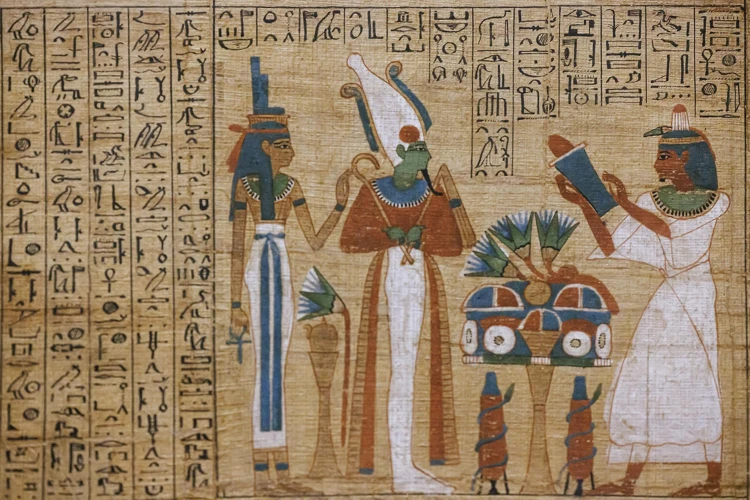
The origins of hieroglyphs trace back to the dawn of ancient Egyptian civilization, with scholars believing that the earliest examples date back to around 3300 BCE. The hieroglyphic writing system evolved from an earlier system of pictographs, where pictures represented objects or concepts. Over time, these pictographs became more stylized and abstract, eventually transforming into hieroglyphs. The significance of hieroglyphs cannot be overstated — they were not just a means of communication but also a reflection of the rich cultural and religious beliefs of the ancient Egyptians. The complexity of the hieroglyphic script posed a challenge to early researchers, with many assuming it to be purely symbolic or mystical. However, through diligent study and the discovery of key artifacts like the Rosetta Stone, scholars began to unravel the mysteries of this ancient writing system. The origins of hieroglyphs remain a topic of fascination and ongoing research, shedding light on the intellectual and artistic achievements of one of the world’s most intriguing ancient civilizations.
Significance of Hieroglyphs
Hieroglyphs held immense significance in ancient Egyptian society, serving not only as a form of writing but also as a powerful tool for cultural expression and religious beliefs. These intricate symbols provided a means for the ancient Egyptians to record and preserve their history, traditions, and knowledge for future generations. Hieroglyphs were inscribed on the walls of temples, tombs, and monuments, acting as both a written language and a visual representation of the ancient Egyptian worldview. They were closely intertwined with the religious practices of the civilization, with many hieroglyphs representing deities, rituals, and mythological concepts. The hieroglyphic script enabled the ancient Egyptians to communicate not only in mundane matters but also in spiritual and metaphysical realms. The ability to decipher hieroglyphs allows us to glimpse into the minds and beliefs of the ancient Egyptians, providing insights into their views on life, death, the afterlife, and the divine. The intricate and artistic nature of hieroglyphs also reveals the Egyptians’ reverence for aesthetics, as they meticulously carved or painted these symbols in vivid colors. Hieroglyphs were not just a practical means of communication but a profound reflection of the ancient Egyptian civilization’s cultural, spiritual, and intellectual legacy. Their significance extends far beyond the written word, making them a captivating subject of study and an invaluable window into the ancient world.
Development of the Writing System
During the development of the writing system, hieroglyphs underwent significant changes and advancements. At the beginning of their use, hieroglyphs were primarily pictographic, with each symbol representing a specific object or concept. However, as the need for a more versatile writing system arose, hieroglyphs began to evolve. The ancient Egyptians realized that representing every word with a separate picture was impractical, so they introduced the concept of phonetic symbols or glyphs. These phonetic hieroglyphs represented specific sounds, allowing for a more flexible and efficient writing system. The development of phonetic hieroglyphs was a crucial step in the evolution of Egyptian writing, enabling scribes to write down names, foreign words, and other terms for which there were no corresponding pictographs. This phonetic addition to the hieroglyphic script expanded its capabilities and provided a bridge to the development of other Egyptian scripts like hieratic and demotic. These scripts were more simplified versions of hieroglyphs and were primarily used for everyday writing tasks. The development of the writing system allowed hieroglyphs to become a more practical and versatile means of communication, as it opened up new possibilities for expressing ideas and recording information. Today, the study of the development of hieroglyphic writing provides valuable insights into the intellectual and cultural progress of ancient Egyptian civilization.
Decoding the Hieroglyphs
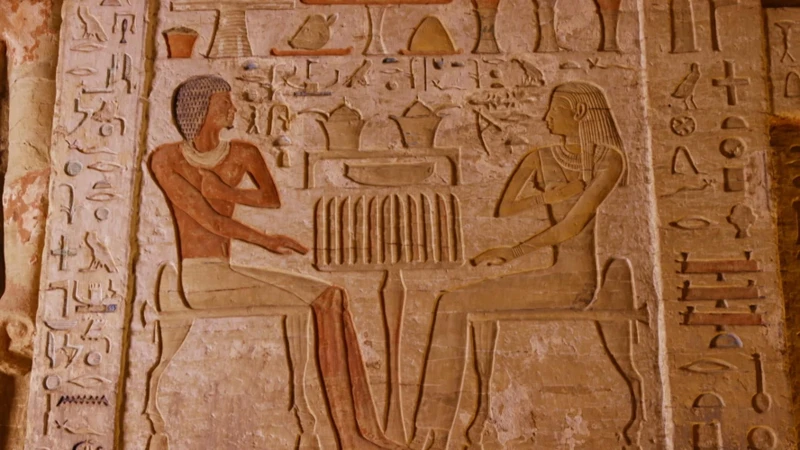
Decoding the hieroglyphs was a monumental task that required a combination of archaeological discoveries, linguistic analysis, and sheer determination. Key breakthroughs in deciphering the hieroglyphic script came with the discovery of the Rosetta Stone in 1799. This stone, inscribed with a decree issued in 196 BCE, contained the same text written in three different scripts: hieroglyphs, Demotic (another Egyptian script), and Greek. French scholar Jean-François Champollion played a pivotal role in deciphering the hieroglyphs. By comparing the known Greek text with the hieroglyphic symbols, Champollion made significant progress in identifying phonetic sounds associated with certain hieroglyphs. He used his knowledge of Coptic, the late form of the Egyptian language, to further unravel the linguistic and grammatical aspects of ancient Egyptian. Through meticulous analysis and comparison, Champollion successfully unlocked the hieroglyphic writing system, opening a window into the ancient Egyptian civilization. The decipherment of hieroglyphs not only allowed for the translation of ancient texts but also provided valuable insights into the history, beliefs, and culture of this ancient society. For more information on how celestial bodies influenced ancient civilizations, you can read about the lunar influence on emotions and intuition.
Key Discoveries
Key discoveries have played a pivotal role in unlocking the secrets of ancient Egyptian hieroglyphs. One of the most significant breakthroughs came with the decipherment of the Rosetta Stone, a stele found in 1799 that contained the same text written in three different scripts: hieroglyphs, demotic script, and Greek. This provided a crucial clue for scholars to compare and relate the characters of the hieroglyphic script to the known Greek language. Another essential discovery was the tomb of Pharaoh Seti I, which contained a wealth of inscriptions and texts in hieroglyphs. These inscriptions helped researchers establish a foundation for understanding the hieroglyphic symbols and grammar. Additionally, the discoveries in the Valley of the Kings, including the tombs of Tutankhamun and Ramesses II, provided further insight into the use of hieroglyphs in tomb decoration and religious texts. The decipherment of hieratic script, a cursive form of hieroglyphs used for everyday writing, also played a crucial role in understanding the language and grammar of hieroglyphs. These key discoveries, along with ongoing archaeological excavations and linguistic analysis, continue to deepen our understanding of ancient Egyptian hieroglyphs and their significance in the civilization’s history. (Reference: /history-origin-ophiuchus-13th-zodiac-sign/)
The Rosetta Stone
The Rosetta Stone, one of the most famous artifacts in the field of Egyptology, played a pivotal role in deciphering the hieroglyphic script. This ancient stone, discovered in 1799 in Rosetta, a town in the Nile Delta, is inscribed with a decree issued by King Ptolemy V in 196 BCE. What makes the Rosetta Stone so significant is that it contains the same decree written in three different scripts: hieroglyphic, Demotic, and Ancient Greek. This provided the key to unraveling the meaning behind the hieroglyphs. The stone itself is a dark gray-pink granite slab, standing about four feet tall and two-and-a-half feet wide. It is inscribed with 54 lines of text, consisting of 14 lines of hieroglyphs, 32 lines of Demotic script, and the final eight lines in Ancient Greek. The discovery of the Rosetta Stone sparked intense interest among scholars, who recognized it as a potential breakthrough in deciphering the hieroglyphs. However, the task proved challenging due to the complexity and variety of signs in the hieroglyphic script. It wasn’t until French scholar Jean-François Champollion devoted himself to the study of the Rosetta Stone that significant progress was made. In 1822, Champollion announced his successful decipherment of the hieroglyphs, unlocking the door to a rich understanding of ancient Egyptian history and culture. The Rosetta Stone remains an iconic symbol of the decipherment process and continues to fascinate researchers and visitors alike, serving as a testament to the power of perseverance and the importance of monumental artifacts in unraveling the mysteries of the past.
Champollion and the Decipherment
Jean-François Champollion, a French scholar, played a pivotal role in deciphering the hieroglyphs and unlocking the secrets of ancient Egypt. Born in 1790, Champollion developed a keen interest in ancient languages from an early age. He dedicated years of his life to studying Coptic, a language closely related to the ancient Egyptian language. Using the Coptic language as a bridge, Champollion made significant breakthroughs in understanding the hieroglyphic script.
One of Champollion’s most notable achievements was his successful decipherment of the Rosetta Stone, a stele inscribed with a decree issued during the reign of Ptolemy V in 196 BCE. The Rosetta Stone contained the same text written in three different scripts: hieroglyphs, demotic script, and Greek. By comparing the Greek text, which was already understood, with the hieroglyphic and demotic scripts, Champollion was able to make crucial connections and identify key symbols and phonetic values.
Champollion’s groundbreaking work solidified the understanding that hieroglyphs were not purely symbolic but encompassed a combination of phonetic and ideographic elements. He meticulously studied and cataloged hieroglyphic signs, eventually creating a comprehensive grammar and dictionary of ancient Egyptian hieroglyphs.
Champollion’s decipherment of the hieroglyphs opened up a new era of understanding and sparked increased interest and exploration of ancient Egypt. His contributions paved the way for further research and allowed scholars to delve deeper into the history, culture, and daily life of the ancient Egyptians. Jean-François Champollion’s work remains highly influential and his decipherment of hieroglyphs stands as one of the most significant achievements in the field of Egyptology. (Reference: role-women-mayan-society)
Understanding Hieroglyphic Symbols
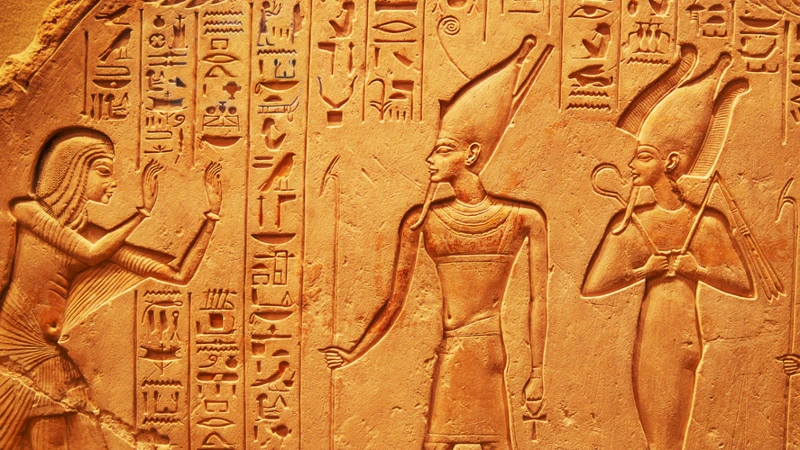
Understanding hieroglyphic symbols is a key aspect of decoding the ancient Egyptian writing system. Hieroglyphs encompass a wide range of symbols that can be categorized into different thematic groups. Religious and mythological symbols were abundant in hieroglyphic script, representing gods, goddesses, and various aspects of religious beliefs. These symbols provided insights into the ancient Egyptians’ spiritual practices and mythology. Everyday life and nature depictions were another important category of hieroglyphs, showcasing scenes from daily activities, plants, and animals. These symbols provided a glimpse into the daily lives and natural environment of ancient Egyptians. Royal and government symbols, on the other hand, highlighted the power and authority of pharaohs and the hierarchy of the Egyptian government. Understanding the meanings behind these different types of hieroglyphic symbols allows us to piece together a more comprehensive understanding of ancient Egyptian society, its values, and its cultural practices.
Religious and Mythological Symbols
Religious and mythological symbols played a significant role in ancient Egyptian hieroglyphs, reflecting the deep religious beliefs and practices of the civilization. These symbols were intertwined with their myths, rituals, and deities, serving as a means to convey spiritual concepts and worship. Some of the prominent religious symbols depicted in hieroglyphs are:
1. Ankh (☥): The Ankh symbol represented life and was closely associated with the gods and the afterlife. It was often held by gods and pharaohs, symbolizing their divine authority and eternal life.
2. Eye of Horus (👁️): The Eye of Horus, also known as the Wedjat or the Eye of Ra, represented protection, health, and royal power. It was believed to have magical and healing properties, and its depictions varied, usually resembling a stylized human or falcon eye.
3. Scarab (🪲): The scarab beetle symbolized regeneration, rebirth, and the sun god Khepri. It was associated with the concept of eternal life and was often used in amulets and jewelry buried with the deceased. The image of the scarab pushing a dung ball was also a metaphor for the sun’s movement across the sky.
4. Falcon (🦅): The falcon, specifically the god Horus, was a prominent deity in Egyptian mythology. The falcon hieroglyph represented Horus and his association with kingship, protection, and divine authority.
5. Djed Pillar (🌳): The Djed pillar was a symbol of stability, representing the backbone of the god Osiris. It was associated with resurrection and eternal life, often depicted with other religious symbols during funerary ceremonies.
These are just a few examples of the numerous religious and mythological symbols found in ancient Egyptian hieroglyphs. The intricate and symbolic nature of these symbols reflects the importance of religion in ancient Egyptian society and their belief in the connection between the mortal realm and the divine.
Everyday Life and Nature Depictions
In ancient Egypt, hieroglyphs were not solely reserved for religious or governmental purposes. They also depicted scenes from everyday life and nature, providing a glimpse into the daily routines and surroundings of the ancient Egyptians. These depictions showcased various aspects of their lives, from farming and fishing to domestic activities and recreation.
1. Farming and Agriculture: Hieroglyphs often depicted scenes of farming and agricultural practices. These included symbols representing plowing, sowing seeds, and harvesting crops such as wheat and barley. Such depictions highlighted the importance of agriculture in Ancient Egyptian society and its role in sustaining the population.
2. Domestic Life: Hieroglyphs showcased the domestic life of the ancient Egyptians, illustrating scenes like cooking, baking, brewing beer, and weaving. These symbols provided insights into the roles played by women in household activities and the essential tasks necessary for daily sustenance.
3. Recreation and Leisure: Hieroglyphs also depicted scenes of leisure activities and entertainment. Symbols representing musical instruments, dancing, hunting, and board games like Senet were common. These depictions showcased the importance of recreation in balancing work and leisure in ancient Egyptian society.
4. Nature and Wildlife: Nature was a vital part of the ancient Egyptians’ lives, and hieroglyphs reflected their deep appreciation for the natural world. Symbols representing animals, plants, trees, and bodies of water were prevalent. Depictions of sacred animals, such as the lion or the ibis, were also common, reflecting their religious significance.
It is through these depictions in hieroglyphs that we gain a comprehensive understanding of the ancient Egyptians’ daily lives and their profound connection with the natural world. The detailed and intricate nature of these symbols showcases the Egyptians’ keen observance and appreciation for every aspect of their existence.
Royal and Government Symbols
Royal and government symbols played a crucial role in ancient Egyptian hieroglyphic writing, highlighting the power, authority, and hierarchical structure of the ruling class. These symbols were used to represent the pharaoh, who was considered a divine ruler and the embodiment of the gods on Earth. One of the most prominent symbols associated with royalty was the “nswt” hieroglyph, which depicted a royal ruler wearing the iconic double crown. This symbol was commonly used to represent the pharaoh and the concept of kingship. Another significant symbol was the “sA” hieroglyph, which represented the power and dominion of the pharaoh. It often depicted a seated figure with the White Crown, symbolizing Upper Egypt.
In addition to symbols representing the pharaoh, government symbols were used to depict various administrative roles and institutions. For example, the “hieroglyph served as a symbol for the palace or the royal residence. It consisted of a rectangle with a flagpole on top, indicating the presence of the pharaoh. The “mnw” hieroglyph represented a government official or administrator, often depicted as a seated figure with an implement or scroll in hand, signifying their authority and responsibilities.
Other symbols related to the government included the “mnx” hieroglyph, which represented the concept of “laws” or “judgment.” It depicted the image of a balanced scale, symbolizing the pharaoh’s role as the ultimate judge and enforcer of justice. The “wn” hieroglyph represented the concept of “authority” or “power,” depicted by a flag on a pole, conveying the idea of the pharaoh’s sovereign authority and control over the land.
These royal and government symbols not only served as a form of written communication but also visually reinforced the hierarchal structure of ancient Egyptian society. They symbolized the divine power and authority of the pharaoh, as well as the institutions and individuals responsible for governing the land. The careful study and understanding of these symbols provide valuable insights into the complexities of ancient Egyptian politics, administration, and governance.
Role of Hieroglyphs in Ancient Egyptian Society
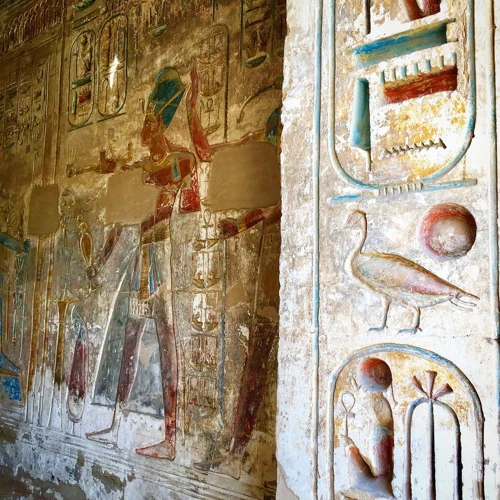
The role of hieroglyphs in ancient Egyptian society was multifaceted and integral to the functioning of their civilization. Hieroglyphs served as a means of communication, allowing the Egyptians to record and convey important information. They were extensively used for record-keeping, documenting everything from historical events to economic transactions. These hieroglyphic texts preserved the knowledge and history of the ancient Egyptians, providing valuable insights into their daily lives and societal structures. Additionally, hieroglyphs played a vital role in religious and ritual practices. Many hieroglyphic inscriptions were found in temples and tombs, illustrating religious beliefs and mythological stories. They were believed to possess magical and protective powers, and thus were commonly inscribed on amulets and talismans. Hieroglyphs played a prominent role in the realm of art and architecture. Elaborate hieroglyphic carvings adorned the walls of temples and tombs, depicting the pharaoh’s divine authority, religious offerings, and celestial symbols. The sophistication and intricacy of hieroglyphs showcased the ancient Egyptians’ reverence for their gods and their desire for artistic expression. Hieroglyphs were pivotal to ancient Egyptian society, serving as a tool for communication, religious devotion, and artistic expression. Their significance continues to captivate researchers and provide invaluable insights into the cultural legacy of this ancient civilization.
Communication and Record-Keeping
In ancient Egyptian society, hieroglyphs played a crucial role in communication and record-keeping. They were used to convey a wide range of information, including personal correspondence, official documents, legal records, and historical accounts. Hieroglyphic inscriptions adorned the walls of temples, tombs, and public buildings, serving as a means of communication for both the living and the deceased. The written word was highly valued, as it ensured the preservation of knowledge and allowed for efficient administrative management. Scribes, who were highly educated individuals, were responsible for the task of recording and documenting various aspects of life. They meticulously transcribed texts onto papyrus scrolls or carved them into stone monuments. The hieroglyphic script was incredibly versatile, offering a vast vocabulary that could express abstract concepts, emotions, and even phonetic sounds. It allowed for precise and detailed record-keeping, ensuring the accurate transmission of information across generations. The ability to communicate effectively through hieroglyphs was essential for the functioning of the ancient Egyptian society, enabling trade, governance, and cultural exchange. The hieroglyphic script’s durability and permanence made it a reliable medium for long-lasting records, offering valuable insights into the history and daily life of the civilization.
Religious and Ritual Use
The hieroglyphs held immense religious and ritualistic significance in ancient Egyptian society. They were considered sacred and believed to be a direct conduit to the divine realm. The priests, who were considered the intermediaries between the gods and the people, used hieroglyphic writing extensively in their religious practices. The temples, dedicated to various deities, were adorned with intricate hieroglyphs that depicted the stories, rituals, and beliefs associated with the gods. These inscriptions served as a means of communicating with the gods and ensuring the well-being of the kingdom. The religious texts, such as the Book of the Dead, were also written in hieroglyphs and were placed in the tombs of the deceased to guide them through the afterlife. Hieroglyphs were not only used in religious ceremonies but also played a vital role in the rituals and practices of everyday life. From offering prayers and conducting ceremonies to recording offerings and donations, hieroglyphic writing was integrated into every aspect of religious and ritualistic activities. The extensive use of hieroglyphs in these contexts highlights the profound spiritual beliefs and deep cultural traditions of the ancient Egyptians. It is through the decipherment and study of these hieroglyphs that we gain a deeper understanding of their religious and ritual practices, offering us a glimpse into their spiritual world.
Art and Architecture
Art and architecture held a central role in ancient Egyptian society, and hieroglyphs played an integral part in their creation and understanding. The hieroglyphic script adorned the walls of tombs, temples, and monuments, leaving a lasting imprint on the landscape of Egypt. In art, hieroglyphs were used to convey more than just written messages; they were intricately incorporated into the visual design, enhancing the storytelling and symbolic significance of the artwork. The Egyptians believed that the hieroglyphs possessed magical powers, and their inclusion in art was believed to bring blessings and protection. Architecture, too, was infused with hieroglyphic inscriptions, with monumental structures like the pyramids and temples featuring walls covered in hieroglyphs. These inscriptions not only served as decorative elements but also conveyed religious and historical narratives. The hieroglyphic texts found in temples often depicted scenes from religious rituals, hymns, and prayers, further solidifying their importance in the religious and spiritual context of ancient Egyptian society. Architectural reliefs and sculptures also incorporated hieroglyphs, providing a visual and written record of the achievements and lineage of pharaohs. The combination of hieroglyphs with visual art and architecture allowed for a multi-dimensional experience that immersed the viewer in the beliefs, stories, and grandeur of the ancient Egyptian world.
The Legacy of Hieroglyphs
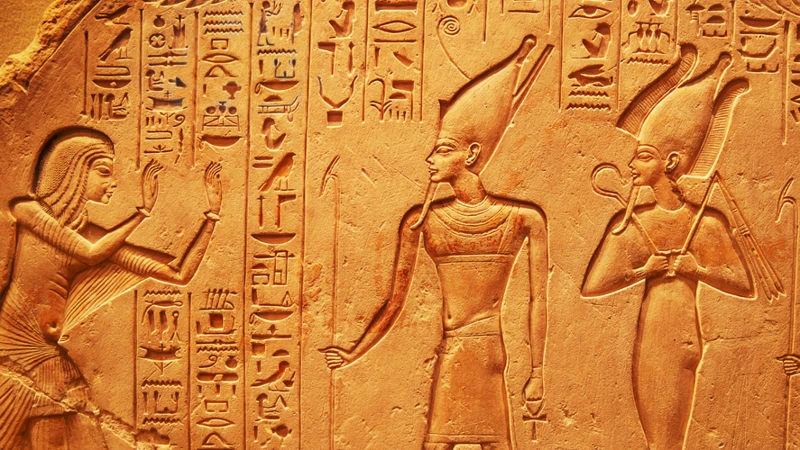
The legacy of hieroglyphs extends far beyond their ancient origins. These intricate symbols have not only provided valuable insights into the ancient Egyptian civilization but have also left a lasting impact on the world of writing systems. The decipherment of hieroglyphs by Jean-François Champollion in the 19th century opened doors to the study of ancient history, linguistics, and culture. Hieroglyphs served as a source of inspiration for other writing systems, such as the Cuneiform script of Mesopotamia and the Mayan hieroglyphs of Central America. Today, hieroglyphs continue to captivate and educate people worldwide, with dedicated efforts to preserve and study this ancient writing system. Online resources, museums, and scholarly institutions foster the study and understanding of hieroglyphs, ensuring their legacy endures for generations to come. So, while the ancient Egyptians may have left behind a rich cultural heritage, it is through hieroglyphs that their stories and contributions are eternally preserved.
Influence on Other Writing Systems
One of the most remarkable aspects of Egyptian hieroglyphs is their profound influence on other writing systems throughout history. The intricate symbols and pictograms used in hieroglyphic writing have served as a source of inspiration for various cultures and civilizations. The influence of hieroglyphs can be seen in the development of other ancient writing systems such as the cuneiform script of Mesopotamia and the Indus Valley script. The concept of using symbols to convey meaning also found its way into the development of Chinese characters, as well as the Mayan script. The phonetic principles employed in deciphering hieroglyphs, particularly by Jean-François Champollion, paved the way for advancements in understanding and deciphering other ancient scripts. The influence of hieroglyphs can even be observed in modern writing systems. For example, the graphic symbols used in emoji and emoticons bear some resemblance to the pictorial nature of hieroglyphs. The enduring legacy of hieroglyphs as a writing system continues to inspire and shape our understanding of language and communication.
Preservation and Study of Hieroglyphs
The preservation and study of hieroglyphs have played a crucial role in unlocking the secrets of ancient Egyptian civilization. Once deciphered, hieroglyphs became a subject of great interest to scholars and Egyptologists, who recognized the immense value of understanding this ancient script. Efforts to preserve hieroglyphs have been undertaken through various means, including the documentation and cataloging of inscriptions on temple walls, tomb walls, and other ancient structures. The creation of digital archives has further facilitated the preservation and accessibility of hieroglyphic texts, allowing researchers around the world to study and analyze these ancient writings. Additionally, the study of hieroglyphs involves not only the interpretation of individual symbols but also the broader understanding of grammar, syntax, and context within texts. Linguists and Egyptologists continue to advance our knowledge of hieroglyphs through ongoing research, deciphering more complex texts and providing deeper insights into the Egyptian civilization. The study of hieroglyphs also extends beyond language, encompassing areas such as religious beliefs, art, and historical records. The preservation and study of hieroglyphs are vital in ensuring that the knowledge and cultural heritage of ancient Egypt are preserved for future generations.
Conclusion
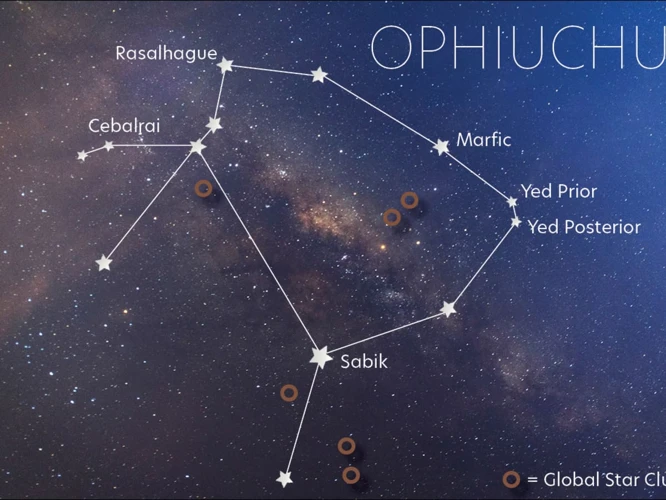
In conclusion, the Egyptian hieroglyphs serve as an invaluable window into the ancient civilization that once thrived along the Nile. These intricate symbols, pictograms, and ideograms provided a means of communication, record-keeping, and artistic expression for the ancient Egyptians. Through the decipherment of hieroglyphs, scholars have gained profound insights into various aspects of their society, from their religious beliefs and rituals to their everyday lives and governance. The legacy of hieroglyphs extends beyond Ancient Egypt, as its influence can be seen in other writing systems and has inspired countless researchers, archaeologists, and linguists to unravel the mysteries of the past. Thanks to ongoing efforts in preservation and study, we continue to expand our understanding of this remarkable ancient writing system. The Egyptian hieroglyphs remain a testament to the creativity, ingenuity, and cultural richness of one of the world’s most fascinating civilizations. As we delve deeper into the hieroglyphic language, we unlock hidden stories and connect with the ancient Egyptians on a profound level, further illuminating the tapestry of human history.
| Key Points to Remember |
|---|
| The hieroglyphic writing system evolved from pictographs and became an essential means of communication for the ancient Egyptians. |
| Deciphering hieroglyphs led to a better understanding of ancient Egyptian religion, daily life, and governance. |
| Hieroglyphs have influenced other writing systems and continue to captivate researchers worldwide. |
| Ongoing preservation and study of hieroglyphs contribute to our expanding knowledge of ancient Egyptian civilization. |
| The legacy of hieroglyphs serves as a testament to the cultural richness and ingenuity of the ancient Egyptians. |
Frequently Asked Questions

What does the word “hieroglyph” mean?
The word “hieroglyph” comes from the Greek words “hieros” meaning “sacred” and “glyphein” meaning “to carve.” Collectively, it refers to the sacred carvings or inscriptions found on ancient Egyptian monuments and artifacts.
How many hieroglyphic symbols are there?
There are thousands of hieroglyphic symbols in the ancient Egyptian writing system. Estimates suggest that there are over 700 distinct hieroglyphs, each representing different concepts, sounds, or objects.
Did everyone in ancient Egypt know how to read and write hieroglyphs?
No, reading and writing hieroglyphs were specialized skills. Only a small portion of the population, such as scribes and priests, received an education that included hieroglyphic writing. It was considered a highly valuable skill in ancient Egyptian society.
How was hieroglyphic writing preserved through the ages?
Hieroglyphic writing was preserved through various mediums such as stone carvings, clay tablets, temple walls, and papyrus scrolls. The dry climate of Egypt and the intentional efforts of ancient Egyptians to preserve their culture contributed to the survival of hieroglyphs.
Are hieroglyphs capable of conveying abstract ideas?
Yes, hieroglyphs were capable of conveying abstract ideas. While many hieroglyphs represented concrete objects or actions, there were also symbolic hieroglyphic signs used to represent more abstract concepts, such as emotions or aspects of religion.
Were there any female hieroglyphic scribes?
While evidence of female hieroglyphic scribes is relatively rare, there is evidence that some women did work as scribes in ancient Egypt. However, it is likely that the majority of scribes were men.
What is the significance of the “Rosetta Stone” in deciphering hieroglyphs?
The Rosetta Stone played a crucial role in deciphering hieroglyphs as it contained inscriptions in three different scripts: hieroglyphs, Demotic, and Greek. By comparing the known Greek text with the unknown hieroglyphic text, scholars were able to decipher the hieroglyphs.
What are some common misconceptions about hieroglyphs?
One common misconception is that each hieroglyph represents a word. In reality, hieroglyphic writing was a combination of phonetic signs, ideograms, and determinatives. Another misconception is that hieroglyphs were primarily used for religious or mystical purposes when they were actually used in various aspects of ancient Egyptian life.
Which other ancient civilizations had writing systems similar to hieroglyphs?
Ancient civilizations such as the Maya and the Aztecs of Mesoamerica, as well as the Sumerians and Babylonians of Mesopotamia, had writing systems that shared some similarities with hieroglyphs. However, each civilization had its own unique characteristics and was not directly derived from Egyptian hieroglyphs.
Can we still learn hieroglyphs today?
Yes, it is possible to learn hieroglyphs today. Scholars and enthusiasts continue to study and decipher ancient Egyptian hieroglyphs, and there are resources available for those interested in learning the basics of this ancient writing system.
References
- How has the study of Ancient Egyptian hieroglyphs …
- How Egyptian hieroglyphs were decoded, a timeline to …
- Famous Ancient Egyptian Symbols and their meanings
Frequently Asked Questions

What are hieroglyphs?
Hieroglyphs were a system of writing used by the ancient Egyptians. They consist of pictorial symbols that represent words and sounds.
How old are hieroglyphs?
Hieroglyphs date back to around 3200 BCE, making them one of the oldest known writing systems in the world.
Why were hieroglyphs important to the ancient Egyptians?
Hieroglyphs played a crucial role in ancient Egyptian society as they were used for communication, record-keeping, religious rituals, and art.
Were hieroglyphs only used for writing?
No, hieroglyphs were not limited to writing alone. They were also used for decorative purposes in the form of elaborate carvings and paintings.
How were hieroglyphs deciphered?
The hieroglyphs were deciphered with the help of the Rosetta Stone, which contained the same text written in three different scripts – hieroglyphic, demotic, and Greek.
Who deciphered the hieroglyphs?
Jean-François Champollion, a French scholar, is credited with deciphering the hieroglyphs. His work on the Rosetta Stone paved the way for understanding the ancient Egyptian writing system.
What do hieroglyphs symbolize?
Hieroglyphs symbolize a wide range of concepts, including deities, nature, everyday objects, and abstract ideas. They provide insights into various aspects of ancient Egyptian life and culture.
Did hieroglyphs have any religious significance?
Yes, hieroglyphs had significant religious importance in ancient Egyptian society. They were used to convey religious myths, rituals, and beliefs.
How did hieroglyphs influence other writing systems?
The study of hieroglyphs has influenced the development of other writing systems, such as the cuneiform script of Mesopotamia. It has also led to advancements in the field of linguistics.
Can hieroglyphs still be seen today?
Yes, hieroglyphs can still be seen today in archaeological sites, museums, and historical monuments in Egypt. They continue to fascinate and captivate people’s interest in ancient civilizations.
References
- 8 Facts About Ancient Egypt’s Hieroglyphic Writing
- Famous Ancient Egyptian Symbols and their meanings
- The Rosetta Stone: A Window into the Ancient Egyptian …







